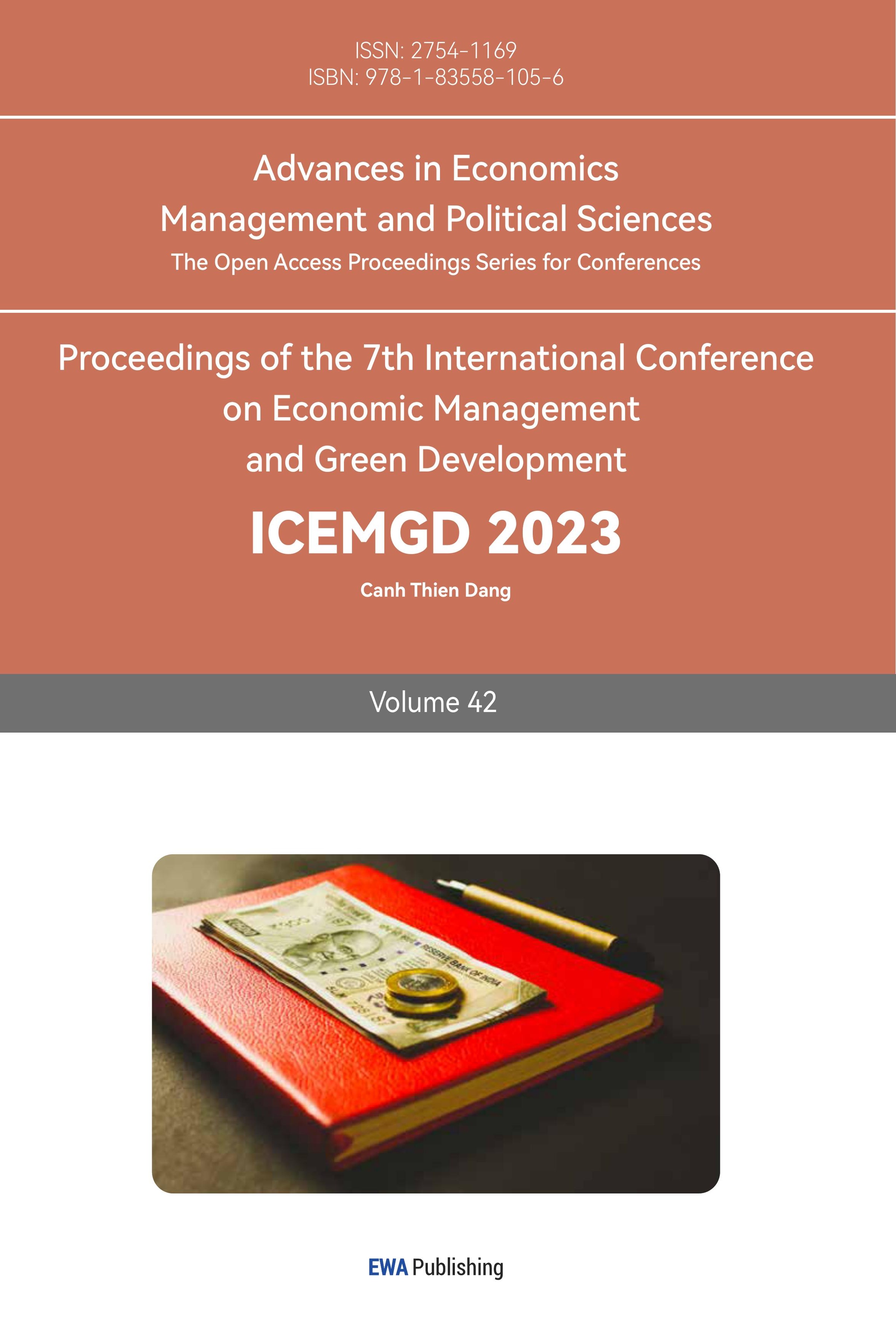References
[1]. Paul L. Nixon's economic policies return to haunt the G.O.P. Review from the New York Times (1976).
[2]. Guan D.B, Wang D.P., Hallegatte S., et al. Global supply-chain effects of COVID-19 control measures. Nature Human Behaviour 4(6), 577-587 (2020).
[3]. NBC Homepage, https://www.nbcnews.com/business/economy/inflation-may-2022-consumer-prices-food-and-gas-rcna32774, last accessed 2022/06/11.
[4]. CNBC Homepage, https://www.cnbc.com/2022/02/03/uk-energy-bills-to-rise-by-over-50percent-in-april-as-ofgem-announces-hike.html, last accessed 2022/02/03.
[5]. Alan S.B., Jeremy B.R. The supply-shock explanation of the great stagflation revisited. CEPS Working Paper 176 (2008).
[6]. Robert B.B., Lutz K. Do we really know that oil caused the great stagflation? A monetary alternative. University of Chicago Press, Chicago (2002).
[7]. James D.H. Historical oil shocks. University of California, San Diego (2010).
[8]. Barthelemy B., Zhen H., Andrei A.L., et al. Global supply chains in the pandemic. Journal of International Economics 133, 103534 (2021).
[9]. David B., Emmanuel F. Supply and demand in disaggregated Keynesian economies with an application to the COVID-19 crisis. American Economic Review 112(5), 1397-1436 (2022).
[10]. Pedro B., et al. Is the COVID-19 pandemic a supply or a demand shock? Federal Reserve Bank of St. Louis (2020).
[11]. Edward N. The great inflation of the seventies: What really happened? Topics in Macroeconomics (2005).
[12]. Michael W., Yuriy G., Olivier C. The expected, perceived, and realized inflation of US households before and during the COVID-19 pandemic. IMF Economic Review, 71 (2022).
[13]. Jesse L., Ana M.S. Global supply chain disruptions and inflation during the Covid-19 pandemic. Federal Reserve Bank of St. Louis Review (2022).
[14]. Adam H.S. How much do supply and demand drive inflation? FRBSF Economic Letter, 15 (2022).
[15]. Ha J., Kose A.M., Ohnsorge F. Global stagflation. MPRA Paper, 113306 (2022).
[16]. Peter S. Europe’s energy crisis will trigger its worst neuroses. The Economist, 9 (2022).
Cite this article
Pang,B. (2023). Is This Time Different? Comparative Analysis of Supply Shocks in the 1970s and 2020s. Advances in Economics, Management and Political Sciences,42,102-109.
Data availability
The datasets used and/or analyzed during the current study will be available from the authors upon reasonable request.
Disclaimer/Publisher's Note
The statements, opinions and data contained in all publications are solely those of the individual author(s) and contributor(s) and not of EWA Publishing and/or the editor(s). EWA Publishing and/or the editor(s) disclaim responsibility for any injury to people or property resulting from any ideas, methods, instructions or products referred to in the content.
About volume
Volume title: Proceedings of the 7th International Conference on Economic Management and Green Development
© 2024 by the author(s). Licensee EWA Publishing, Oxford, UK. This article is an open access article distributed under the terms and
conditions of the Creative Commons Attribution (CC BY) license. Authors who
publish this series agree to the following terms:
1. Authors retain copyright and grant the series right of first publication with the work simultaneously licensed under a Creative Commons
Attribution License that allows others to share the work with an acknowledgment of the work's authorship and initial publication in this
series.
2. Authors are able to enter into separate, additional contractual arrangements for the non-exclusive distribution of the series's published
version of the work (e.g., post it to an institutional repository or publish it in a book), with an acknowledgment of its initial
publication in this series.
3. Authors are permitted and encouraged to post their work online (e.g., in institutional repositories or on their website) prior to and
during the submission process, as it can lead to productive exchanges, as well as earlier and greater citation of published work (See
Open access policy for details).
References
[1]. Paul L. Nixon's economic policies return to haunt the G.O.P. Review from the New York Times (1976).
[2]. Guan D.B, Wang D.P., Hallegatte S., et al. Global supply-chain effects of COVID-19 control measures. Nature Human Behaviour 4(6), 577-587 (2020).
[3]. NBC Homepage, https://www.nbcnews.com/business/economy/inflation-may-2022-consumer-prices-food-and-gas-rcna32774, last accessed 2022/06/11.
[4]. CNBC Homepage, https://www.cnbc.com/2022/02/03/uk-energy-bills-to-rise-by-over-50percent-in-april-as-ofgem-announces-hike.html, last accessed 2022/02/03.
[5]. Alan S.B., Jeremy B.R. The supply-shock explanation of the great stagflation revisited. CEPS Working Paper 176 (2008).
[6]. Robert B.B., Lutz K. Do we really know that oil caused the great stagflation? A monetary alternative. University of Chicago Press, Chicago (2002).
[7]. James D.H. Historical oil shocks. University of California, San Diego (2010).
[8]. Barthelemy B., Zhen H., Andrei A.L., et al. Global supply chains in the pandemic. Journal of International Economics 133, 103534 (2021).
[9]. David B., Emmanuel F. Supply and demand in disaggregated Keynesian economies with an application to the COVID-19 crisis. American Economic Review 112(5), 1397-1436 (2022).
[10]. Pedro B., et al. Is the COVID-19 pandemic a supply or a demand shock? Federal Reserve Bank of St. Louis (2020).
[11]. Edward N. The great inflation of the seventies: What really happened? Topics in Macroeconomics (2005).
[12]. Michael W., Yuriy G., Olivier C. The expected, perceived, and realized inflation of US households before and during the COVID-19 pandemic. IMF Economic Review, 71 (2022).
[13]. Jesse L., Ana M.S. Global supply chain disruptions and inflation during the Covid-19 pandemic. Federal Reserve Bank of St. Louis Review (2022).
[14]. Adam H.S. How much do supply and demand drive inflation? FRBSF Economic Letter, 15 (2022).
[15]. Ha J., Kose A.M., Ohnsorge F. Global stagflation. MPRA Paper, 113306 (2022).
[16]. Peter S. Europe’s energy crisis will trigger its worst neuroses. The Economist, 9 (2022).









